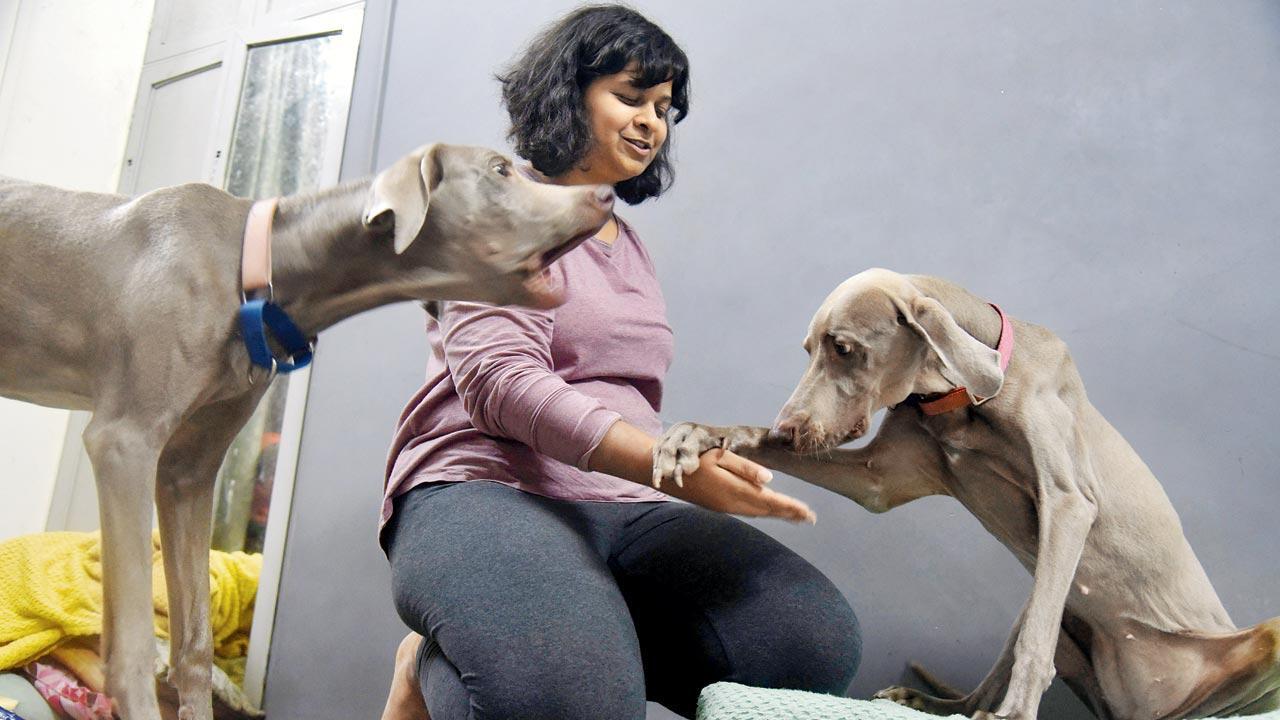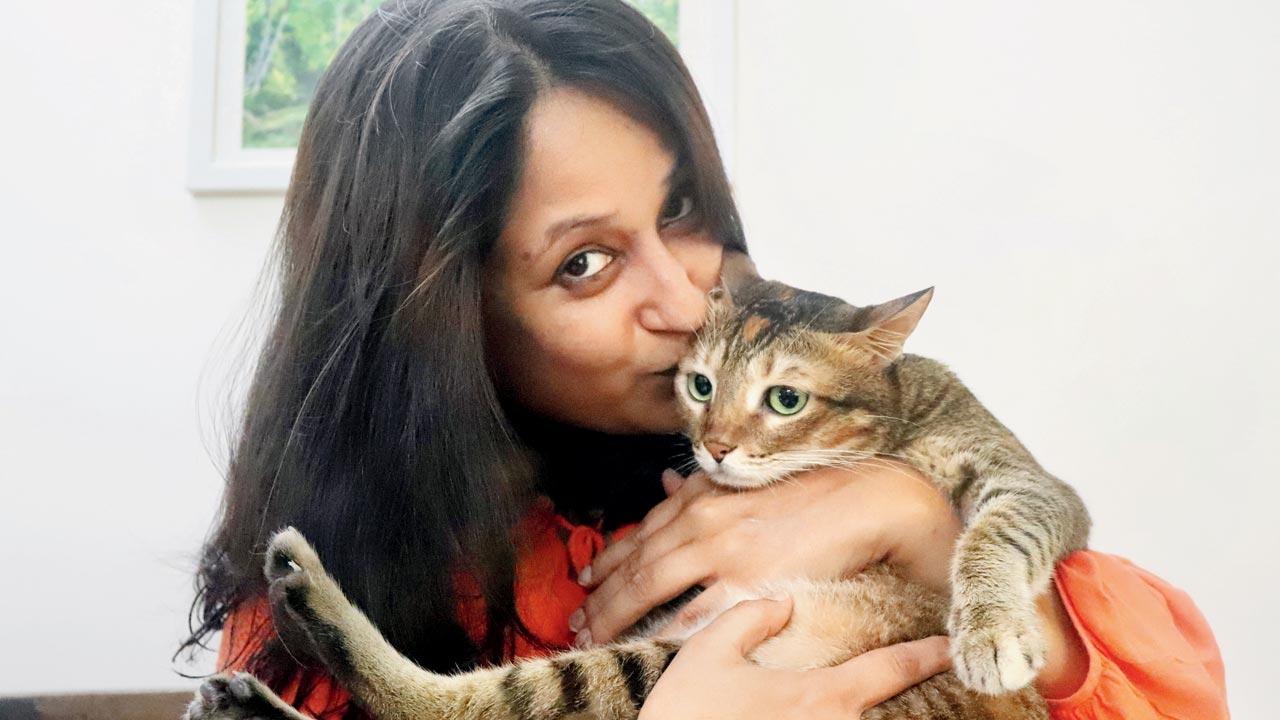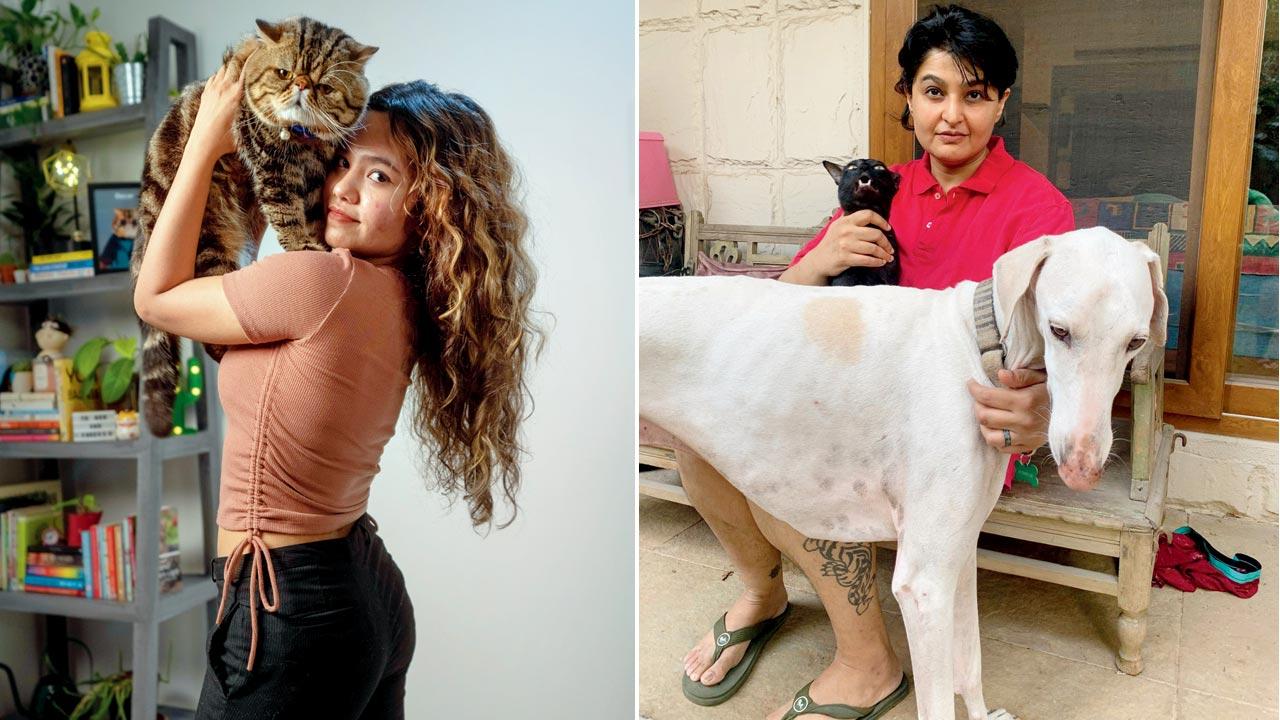Human-animal communication is a two-way street, and your cat or dog is training you to do things for them without using commands or rewards. So, who’s the clever girl now

@pradnya58: Rory the Weimaranar is sensitive to loud sounds, and starts barking at Pradnya Hattiangadi and her husband Sanket Chaudhary when they get into spirited conversations. Pradnya is similarly discouraged when she says, “Oh shit!” and has now deleted it from her vocabulary. Pic/Sameer Markande
A cynic may say humans love dogs because they do what you want them to. There’s evidence to suggest that cats say the same about humans: “Oh Felix, you’re only keen on that human because she shares her food at one meow,” Tom, the colony cat, might say. And so would Casper, the
yellow Labrador.
ADVERTISEMENT
Training a pet is a two-way process. S/he is also moulding your behaviour to get what s/he wants, just as you are. And instead of giving a command and rewarding that desired behaviour with treats, our cat or dog rewards us by purring, cuddling, rubbing or wagging her tail; or by stopping that godawful mewing. We won’t insult you, dear reader, by asking who the better trainer is. The happy fact is, just like any relationship, you give a bit to receive a lot more.
 Urvashi Pant’s Smarty Pants was taken off dairy for a while for medical reasons. But she noticed Pant pours some into her evening tea, and pops up in the kitchen every time she smells the tea brewing and stares at the milk carton in Pant’s hand. “I usually give her some in the cup of my hand, and on most occasions, it’s chilled.” Pic/Anurag Ahire
Urvashi Pant’s Smarty Pants was taken off dairy for a while for medical reasons. But she noticed Pant pours some into her evening tea, and pops up in the kitchen every time she smells the tea brewing and stares at the milk carton in Pant’s hand. “I usually give her some in the cup of my hand, and on most occasions, it’s chilled.” Pic/Anurag Ahire
Cats and dogs have evolved to read humans better. Dogs were the first animal domesticated by us, and they adapted—helped by selective breeding—to display behaviours that assured a warm place to sleep and an unending supply of food. That’s how they learnt to make bigger puppy eyes, move their eyebrows, have more control over facial muscles to mimic wide smiles, tucking in of the upper or lower lips. They also developed a physical and verbal vocabulary: whining, a small, short bark, nosing us with their cold, wet proboscis, pawing to indicate a toilet break, and chinning.
Cats domesticated themselves, and that’s why they haven’t changed much as a species besides an imperceptible change in size. “The brains got smaller over time with domestication,” says feline behaviourist Amanda Tong, “the amygdala—the fear centre in the brain—shrunk. They didn’t need to be so vigilant all the time as dangers decreased as they adapted to human society.” Don’t be fooled, though. Cats can still survive in the wild and look very much like the African wild cat they evolved from. Compare that to the difference between a wolf and a pug. As humankind began storing food grains, vermin flocked to the buffet and cats followed. Humans then adjusted the environment to keep the useful pest control agents around, and built temples for them. House cats no longer need to hunt, but humans are trained to play games that mimic hunting moves such as stealth, stalking, pounce, grab. “We have adapted to their needs,” says Tong. That’s the truth about cats and dogs. You may lure them with food to come to you, but play makes them stay.
 @oscarthebullcat: Oscar politely wags his tail to tell Amanda Tong to stop rubbing his belly. Tail wags mean different things in dogs and cats. Pic/Bark Butler; (right) @citizenk9india: Raj Mariwala’s Mudhol hound Nimbu knows that when she goes up the flight of stairs at night, Mariwala is retiring for the day. If he wants some kind of engagement, he will block her way and they play. Scooty the cat also gangs up with Nimbu to get what they want from the humans of the house
@oscarthebullcat: Oscar politely wags his tail to tell Amanda Tong to stop rubbing his belly. Tail wags mean different things in dogs and cats. Pic/Bark Butler; (right) @citizenk9india: Raj Mariwala’s Mudhol hound Nimbu knows that when she goes up the flight of stairs at night, Mariwala is retiring for the day. If he wants some kind of engagement, he will block her way and they play. Scooty the cat also gangs up with Nimbu to get what they want from the humans of the house
Irrefutable evidence that all this ‘talking’ is just for us is that both species do not use this vocabulary to communicate within their peer groups. Cats don’t meow at each other: They hiss at arch enemies and mewl for mothers. Dogs don’t use puppy eyes on the pack leader or prospective mate (but humans do…).
“Cats mainly use olfactory cues within the species,” says Tong, “So, the vocalisation [mewing] is for us. Because of their stereotyping as an unfeeling, selfish species, we miss out on noticing their range and association.”
Cats and dogs are acutely observant and cats have mimicked our range to communicate with us. “They have about 21 different ranges of vocalisation,” says Tong of The Animal Behaviour Academy. “Just as our high tones indicate excitement and happiness, high-pitched meows indicate positive emotion, while lower ranges are negative.” Just like our mother’s low-pitched threat that we take most seriously. “Cats appear to have modulated their pitch to bridge that communication,” says Tong.
It’s devious that the pitch of the ‘meow’ for food is at the same decibel levels as a human infant’s cry for nourishment. A pitch we are hardwired to respond to as species to ensure our survival. Cats deserved ancient Egypt.
Further, cats communicate differently with each human. Raj Mariwala, a canine and feline behaviourist, would know. Her cat, Buggy, lightly licks her brows to wake her up for a midnight snack, but whacks any other sleeping family member across the face to reach the same end. “I am a light sleeper,” reasons Mariwala, who lives in Bandra. So cats change the sound of their meow, depending on the response of the human. “They will bring an urgency [or irritability] to it that you can’t ignore,” she says. “They will escalate matters till they get what they want.”
And if you are a quick-thinking human, the cat will just use her/his gaze or stare. And if you are a dense one, s/he knows how to train you too. “Cats are extremely observant of small things about humans, because it links to survival,” says Tong. “And know how to get the attention of a specific human; so s/he may pull the tissues from a box to get one person in the house to look up; and push the specs off the table for the other one to look up. A cat I know does this only to ask for physical affection. She values it enough to modify her behaviour to seek it.”
Our benevolent dictators, of both species, also wait patiently until we go through a trial-and-error process to guess what they want to say. “If you offer a cat affection when s/he meows,” says Mariwala, “S/he’ll accept it, but will still meow as you keep offering another alternative—a toy perhaps—and stop only when you hit the bullseye.” Rest assured, you will offer the treat first, the next time s/he meows. A good rule of thumb, offers Tong, whatever stops the cat meowing is what s/he wanted in the first place.
This writer’s dog trained her two years ago to switch on the AC. He pawed her, which is usually a request for food or walks, but in the middle of the night. He then waited for her to associate his heavy panting with discomfort, and turned around to go to bed the instant he heard the beep of the air-conditioner being switched on. It’s the first thing she reaches for when he wakes her in the middle of the night now.
They’ll also drop environmental cues, and the communication widens depending on the ingenuity of the human. “I had to learn associations,” says Tong. “Most cats will go to where the food is kept to indicate hunger, but my cat goes to the fridge to indicate AC and to his bowl for food. “ Tong’s field of education makes her a quick learner.
A scared cat who boards with Mariwala when the cat’s parents travel has learnt to keep Mariwala close. “We keep him in a separate room and he eats only in the presence of humans,” she says. “He knows that if I eat when no one is there, the human visits will get fewer. Longer human visits mean affection and play. And he does this behaviour here only. He will only eat if a human is in the room talking to him, and he is not really a food-centric cat.”
Think of how a cat has taught you where s/he likes to be touched. A scratch behind the ears will get a purr, but a quick swipe teaches you to never touch the stomach or the tip of the tail.
Not just humans, cats also learn to communicate with dogs they live with and love. Chom chom, the black moggie will groom, sits next to Tequila, the dog, and purrs when the latter is agitated by fireworks.
Dogs bring the whole body into the conversation, as well as the stare. “Between dogs,” says Mariwala, “a head-on stare is a challenge or provocation, but they know it can be used on humans to communicate more benignly. Dogs learn to modify our behaviours through looking and pointing (Ask your dog ‘What?’ the next time s/he stares at you, and s/he may lead to a toy or point to the door), but they observe and note our patterns.” They know you head to the biscuit box at a certain point in the evening and sit down for tea, and every dog worth her nose is in the kitchen at the appointed time.
And they are stoic optimists. “I have an evening coffee ritual,” says Mariwala, “and I played with my black cat a few times during it. Now she will come and stare at me and initiate play at that time.”
Socialisation is key to how good a cat or dog gets at training humans. The more people they meet as young, and the wider range of people, the more they pick up on human body language and patterns. As their survival is far more dependent on humans, dogs are more invested in teaching you what they want and will drop ample cues to goad you along.
If a pointed stare does not do it, they will go to the door or pick up the leash to tell you it’s time for a walk. “They pick and choose cues,” says Mariwala, “They will pick up a toy, push through our legs, bark at you, steal your shoes, giving you different clues until you catch up.” Once the connection is established, they try it on new humans and you helpfully tell the guests that your dog wants a belly rub when s/he puts her legs up in the air. Good girl, you.
Dogs also have the ability to connect things. “Nimbu [her Mudhol hound] knows the difference between the boxer shorts I wear at home and the clothes I wear to train other dogs, and the clothes I wear to walk him. He only stirs when I wear the last ensemble,” says Mariwala.”
He also knows that when she goes up the flight of stairs at night, Mariwala is retiring for the day and will not come back down until the morning. “If he wants some kind of engagement,” she says. “He will stop me from going up the stairs by blocking me. He doesn’t do this during the day because he knows I will come back down.”
The ace up the pet’s sleeve for modifying our behaviour is the realisation of how much we value the young of our species. Dogs and cats are known to hang around babies and children, and be alert to their cries because they notice how quickly we respond to it. We also display favourable body language when we see a dog or cat around a baby—our facial features soften, we smile or coo, reach down to pet the animal or even toss a treat. And so they park themselves near the crib.
What’s more? Cats and dogs will work together to jointly manipulate humans. A cat may rub against your legs and mew intolerably until you go to the cupboard where her treats are. And the dog is already waiting there, to remind you with puppy eyes, that you can’t be heartless enough to leave him out, would you?
So how do you know if your pet is training you? Does a pointed look at 3 pm send you to the fridge? Does she do a ‘Sit’ before you even ask, and then you reward her for it? Clever human, you.
 Subscribe today by clicking the link and stay updated with the latest news!" Click here!
Subscribe today by clicking the link and stay updated with the latest news!" Click here!







